Assessment |
Biopsychology |
Comparative |
Cognitive |
Developmental |
Language |
Individual differences |
Personality |
Philosophy |
Social |
Methods |
Statistics |
Clinical |
Educational |
Industrial |
Professional items |
World psychology |
Social psychology: Altruism · Attribution · Attitudes · Conformity · Discrimination · Groups · Interpersonal relations · Obedience · Prejudice · Norms · Perception · Index · Outline
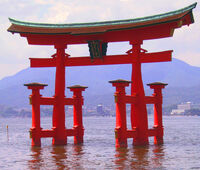
A torii at Itsukushima Shrine
Shinto (Kanji: 神道 Shintō) (sometimes called Shintoism) is a native religion of Japan and was once its state religion. It is a form of animism. It involves the worship of kami, which can be translated to mean "sacred spirits which take the form of things and concepts important to life, such as wind, rain, mountains, trees, rivers and fertility". Some kami are local and can be regarded as the spirit or genius of a particular place, but others represent major natural objects and processes, for example, Amaterasu, the Sun goddess. The word Shinto was created by combining two kanji: "神" shin, meaning gods or spirits (the character can also be read as "kami" in Japanese), and "道" tō meaning "way" or "path" in a philosophical sense (the same character is used for the Chinese word Tao). As such, Shinto is commonly translated as "the way of the gods."
After World War II, Shinto lost its status of state religion; some Shinto practices and teachings, once given a great deal of prominence during the war, are no longer taught nor practiced today, and others remain largely as everyday activities, like omikuji (a form of drawing lots) and Japanese New Year, that few identify with religious connotations.
History[]
Early History[]
A number of theories exist about the ancestors of today's Japanese. Most scholars accept there was migration from central Asia and to a lesser extent from Indonesia, though there Shinto first developed. Nationalists claim that it has always existed, back into the mists of the Jomon age. Others maintain that it came about in the Yayoi age as the result of immigrants from China and Korea, who brought agricultural rites and shamanic ceremonies from the continent which took on Japanese forms in the new environment. Some modern scholars now claim that "Shinto" as it is presently understood did not exist in this age at all and should be more properly referred to as 'kami worship'.
In the early centuries BCE, each tribe and area had its own collection of gods with no formal relationship between them. However, following the ascendency of the Yamato Kingdom around the third to fifth centuries, the ancestral deities of its Imperial family were given prominence over others and a narrative made up to justify it. The result was the mythologising of Kojiki (712) in which it was claimed that the imperial line descended directly from the sun-goddess herself. Another important kingdom, Izumo, was dealt with in a separate cycle within the mythology and its deities incorporated into service of Amaterasu's descendants. A more objective and historical version of events appeared in Nihon Shoki (720), where alternative versions of the same story are given.
Early shrines are thought to have been held outside before copses or sacred rocks (iwakura). There was no representation of the kami, for they were conceived as formless and pure. After the arrival of Buddhism in the sixth century, the idea of building 'houses' for the kami arose and shrines were built for the first time. The earliest examples are thought to have been at Izumo (659) and Ise (690).
An important development was the introduction of the Ritsuryo System in the late seventh and early eighth centuries, based on the Chinese system. This established in law the supremacy of the emperor and great nobles, as well as formalising their relationship to major shrines and festivals.
Even before the arrival of Buddhism, the rituals involved in kami worship had borrowed from Chinese Taoism and Confucianism. Though clan rivalry led to friction and fighting during the introduction of Buddhism, the worship of kami and buddha soon settled down into happy coexistence. In fact the emergence of a syncretic shin-butsu (Shinto-buddhism) was to become the dominant feature of Japanese religion as a whole.
Shinto and Buddhism[]
The introductions of writing in the 5th century and Buddhism in the 6th century had a profound impact on the development of a unified system of Shinto beliefs. Within a brief period of time, in the early Nara period, the Kojiki (The Record of Ancient Things, 712) and the Nihonshoki (The Chronicles of Japan, 720) were written by compiling existing myths and legends into a unified account (see: Japanese mythology). These accounts were written with two purposes in mind. First, the introduction of Taoist, Confucian, and Buddhist themes into Japanese religion. Second, to shore up support for the legitimacy of the Imperial house, based on its lineage from the Sun Goddess Amaterasu. Much of the area of modern Japan was under only fragmentary control by the Imperial family, and rival ethnic groups (including, perhaps, the ancestors of the Ainu) continued to war against the encroachment of the Japanese. The mythological anthologies, along with other poetry anthologies like the Manyoshu and others, were all meant to impress others with the worthiness of the Imperial family and their divine mandate to rule.
With the introduction of Buddhism and its rapid adoption by the court, it was necessary to explain the apparent differences between native Japanese beliefs and Buddhist teachings. Indeed, Shinto did not have a name until it became necessary to distinguish it from Buddhism. One explanation saw the Japanese kami as supernatural beings still caught in the cycle of birth and rebirth. The kami are born, live, die, and are reborn like all other beings in the karmic cycle. However, the kami played a special role in protecting Buddhism and allowing its teachings of compassion to flourish. This explanation was later challenged by Kukai, who saw the kami as different embodiments of the Buddhas themselves. For example, he famously linked Amaterasu, Sun Goddess and ancestor of the Imperial family, with Dainichi Nyorai, a central manifestation of the Buddha, whose name is literally "Great Sun Buddha". In his view, the kami were just Buddhas by another name.
Buddhism and Shinto coexisted and were amalgamated in the Shinbutsu Shugo and Kukai's syncretic view held wide sway up until the end of the Edo period. At that time, there was a renewed interest in "Japanese studies" (kokugaku), perhaps as a result of the closed country policy. In the 18th century, various Japanese scholars, in particular Motoori Norinaga (1730–1801), tried to tease apart the "real" Shinto from various foreign influences. The attempt was largely unsuccessful; since as early as the Nihonshoki, parts of the mythology were explicitly borrowed from Chinese doctrines. (For example, the co-creator deities Izanami and Izanagi are explicitly compared to yin and yang.) However, the attempt did set the stage for the arrival of state Shinto, following the Meiji Restoration, when Shinto and Buddhism were separated (Shinbutsu bunri).
State Shinto[]
Following the Meiji Restoration, Shinto was made the official religion of Japan, and in 1868 its combination with Buddhism was outlawed. During this period, it was felt by numerous scholars of kokugaku that Shinto was needed in order to unify the country around the Emperor as the process of modernization was undertaken with all possible speed. The psychological shock of the Western "Black Ships" and the subsequent collapse of the shogunate convinced many that the nation needed to band together if it was going to resist being colonized by outside forces. As a result, Shinto was used as a tool for promoting Emperor (and Empire) worship, and Shinto was exported into conquered territories like Hokkaido and Korea.
In 1871, a Ministry of Divinities was formed and Shinto shrines were divided into twelve levels with Ise Shrine (dedicated to Amaterasu, and thus symbolic of the legitimacy of the Imperial family) at the peak and small sanctuaries of humble towns at the base. The following year, the ministry was replaced with a new Ministry of Religion, charged with leading instruction in "shushin" (moral courses). This was a major reverse from the Edo period, in which families were registered with Buddhist temples, rather than Shinto shrines. Priests were officially nominated and organized by the state, and they instructed the youth in a form of Shinto theology based on the official history of divinity of Japan's national origins and its Emperor.
As time went on, Shinto was increasingly used in the advertising of nationalists popular sentiments. In 1890, the "Imperial Rescript on Education" was passed, and students were required to ritually recite its oath to "offer yourselves courageously to the State" as well as protect the Imperial family. The practice of Emperor worship was also further spread by distributing imperial portraits for esoteric veneration. All of these practices were used to fortify national solidarity through patriotic centralized observance at shrines. This use of Shinto gave to Japanese patriotism a special tint of mysticism and cultural introversion, which became more pronounced as time went on.
Such processes continued deepening until the Showa Period, before coming to an abrupt halt in August 1945. Somewhat ironically, the invasion by the West so feared at the start of the Meiji era had come at last, due at least in part, to the radicalization of Japan permitted by its religious solidarity.
Post-War[]
The era of State Shinto came to an abrupt close with the end of World War II. It appeared that the kami had failed to provide a Divine Wind (kamikaze) to turn back the foreign invaders. Soon after the war, the Emperor issued a statement renouncing his claims to the status of "living god." In the aftermath of the war, most Japanese came to believe that the hubris of Empire had led to their downfall. Lust for foreign territory blinded their leaders to the importance of their homeland. In the post-war period, numerous "New Religions" cropped up, many of them ostensibly based on Shinto, but on the whole, Japanese religiosity may have decreased. However, the concept of religion in Japan is a complex one. A survey conducted in the mid-70's indicated that of those participants who claimed not to believe in religion, one-third had a Buddhist or Shinto altar in their home, and about one quarter carried an o-mamori (an amulet to gain protection by kami) on their person. Following the war, Shinto has, for the most part, persisted with less importance placed on mythology or the divine mandate of the Imperial family. Instead, shrines tend to focus on helping ordinary people gain better fortunes for themselves through maintaining good relations with their ancestors and other kami. Post-war, the number of Japanese citizens identifying their religious beliefs as Shinto has declined a good deal, yet the general practice of Shinto rituals has not decreased accordingly, and many practices have persisted as general cultural beliefs (such as ancestor worship, which is still very popular), superstitions, and community matsuri (festivals) - focusing more on religious practices and items than principles. The explanation generally given for this anomaly is that, following the demise of State Shinto, Shinto has reverted to its more traditional position as a folk religion which is culturally ingrained, rather than enforced. In any case, Shinto and its values continue to be an important component of the Japanese cultural mindset.
Definition of Shinto[]
Shinto can be seen as a form of animism and may be regarded as a variety of shamanist religion. Shinto beliefs and ways of thinking are deeply embedded in the subconscious fabric of modern Japanese society. The afterlife is not a primary concern in Shinto, and much more emphasis is placed on fitting into this world, instead of preparing for the next. Shinto has no binding set of dogma, no holiest place for worshippers, no person or kami deemed holiest, and no defined set of prayers. Instead, Shinto is a collection of rituals and methods meant to mediate the relations of living humans to kami. These practices have originated organically in Japan over a span of many centuries and have been influenced by Japan's contact with the religions of other nations, especially China. Notice, for example, that the word Shinto is itself of Chinese origin and that much of the codification of Shinto mythology was done with the explicit aim of answering Chinese cultural influence. Conversely, Shinto had and continues to have an impact on the practice of other religions within Japan. In particular, one could even make a case for discussing it under the heading of Japanese Buddhism, since these two religions have exercised a profound influence on each other throughout Japanese history. Further, the Japanese "New religions" that have emerged since the end of the Second World War have also shown a clear Shinto influence.
Some feel Shinto was used as a legitimising ideology during the militaristic phase of Japanese history following the Meiji Restoration. Because Shinto has no absolute source of authority, some feel what was a natural expression of the beliefs of the people was hijacked by radical Nationalists, who desired to unify the Japanese people against the "inferior" people in other nations. Others wonder if the emphasis Shinto places on Japanese exceptionalism made such developments inevitable. Even today, some far right factions within Japanese society want to see a greater emphasis placed on Shinto and increased reverence shown to the Emperor as part of a project to restore Japan to its "rightful place" as the leading nation of the world. However, for most Japanese, Shinto is not about expressing disdain for other nations but expressing one's own love of the natural landscape of Japan and the people and spirits that reside within it.
Types of Shinto[]
In order to distinguish between these different focuses of emphasis within Shinto, many feel it is important to separate Shinto into four related types of Shinto expression.
- Shrine Shinto is the oldest and most prevalent of the Shinto types. It has always been a part of Japan's history and constitutes the main current of Shinto tradition.
- Sect Shinto is comprised of thirteen groups formed during the 19th century. They do not have shrines, but conduct religious activities in meeting halls. Shinto sects include the mountain-worship sects, who focus on worshipping mountains like Mt. Fuji, faith-healing sects, purification sects, Confucian sects, and Revival Shinto sects. Konkokyo, although operating separately from modern Shinto, is considered to be a form of Sect Shinto.
- Folk Shinto includes the numerous but fragmented folk beliefs in deities and spirits. Practices include divination, spirit possession, and shamanic healing. Some of their practices come from Taoism, Buddhism, or Confucianism, but some come from ancient local traditions.
- State Shinto was the result of the Meiji dynasty's restoration and the downfall of the shogunate. The Meiji attempted to purify Shinto by abolishing many Buddhist and Confucian ideals; also, the emperor was once again considered divine. After Japan's defeat in World War II, State Shinto was abolished and the emperor was forced to renounce his divine right.
Characteristics of Shinto[]
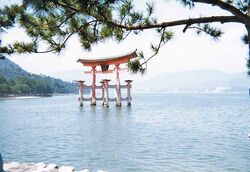
Torii at Itsukushima Shrine
The most immediately striking theme in the Shinto religion is a great love and reverence for nature. Thus, a waterfall, the moon, or just an oddly shaped rock might come to be regarded as a kami; so might charismatic persons or more abstract entities like growth and fertility. As time went by, the original nature-worshipping roots of the religion, while never lost entirely, became attenuated and the kami took on more reified and anthropomorphic forms, with a formidable corpus of myth attached to them. (See also: Japanese mythology.) The kami, though, are not transcendent deities in the usual Western and Indian sense of the word - although divine, they are close to us; they inhabit the same world as we do, make the same mistakes as we do, and feel and think the same way as we do. Those who died would automatically be added to the rank of kami regardless of their human doings. (Though it is thought that one can become a ghost under certain circumstances involving unsettled disputes in life.) Belief is not a central aspect in Shinto, and proper observation of ritual is more important than whether one "truly believes" in the ritual. Thus, even those believing other religions may be venerated as kami after death, if there are Shinto believers who wish them to be.
Practice and teaching of Shinto[]
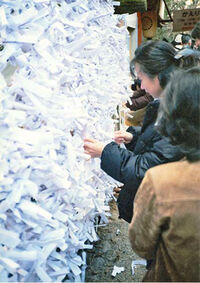
Tying her omikuji (fortune) at Kasuga Shrine
Afterlife[]
Unlike many religions, one does not need to publicly profess belief in Shinto to be a Shintoist. Whenever a child is born in Japan, a local Shinto shrine adds the child's name to a list kept at the shrine and declares him or her "Ujiko", literally named child. After death an "Ujiko" becomes an "Ujigami"; literally, named kami. One may choose to have one's name added to another list when moving and then be listed at both places. Names can be added to the list without consent and regardless of the beliefs of the person added to the list. However, this is not considered an imposition of belief, but a sign of the welcome of the area kami, with the promise of addition to the pantheon of kami after death. Those children who die before addition to the list are called "Mizuko", literally water child, and believed to cause troubles and plagues. "Mizuko" are often worshipped in a Shinto shrine dedicated to stilling their anger and sadness. These shrines have become more popular with the growth of abortion in modern Japan.
Because Shinto has co-existed with Buddhism for well over a millennium, it is very difficult to disentangle Shinto and Buddhist beliefs about the world. One might say that where Buddhism emphasizes the afterlife and ending the cycle of rebirths, Shinto emphasizes this life and finding happiness within it. Though Buddhism and Shinto have very different perspectives on the world, most Japanese do not see any challenge in reconciling these two very different religions, and practice both. Thus it is common for people to practice Shinto in life yet have a Buddhist funeral. Their different perspectives on the afterlife are seen as complementing each other, and frequently the ritual practice of one will have an origin in the other.
Four affirmations[]
Though Shinto has no absolute commandments for its adherents outside of living "a simple and harmonious life with nature and people", there are said to be "Four Affirmations" of the Shinto spirit:
- Tradition and the family: The family is seen as the main mechanism by which traditions are preserved. Their main celebrations relate to birth and marriage.
- Love of nature: Nature is sacred; to be in contact with nature is to be close to the kami. Natural objects are worshipped as containing sacred spirits.
- Physical cleanliness: Followers of Shinto take baths, wash their hands, and rinse out their mouth often.
- "Matsuri": Any festival dedicated to the Kami, of which there are many each year.
Impurity[]
Shinto teaches that certain deeds create a kind of ritual impurity that one should want cleansed for one's own peace of mind and good fortune, not because impurity is wrong in and of itself. Wrong deeds are called kegare (literally, "dirtiness"), opposed to kiyome (purity). Normal days are called ke (day), and festive days are called hare (sunny, or simply good). Killing living beings should be done with reverence for taking a life to continue one's own, and should be kept to a minimum. Modern Japanese continue to place great emphasis on the importance of aisatsu, or ritual phrases and greetings. Before eating, many (though not all) Japanese say "itadakimasu" ("I will humbly receive [this food]") in order to show proper thankfulness to the preparer of the meal in particular and more generally to all those living things that lost their lives to make the meal. Failure to show proper respect can be seen as a lack of concern for others, looked down on because it is believed to create problems for all. Those who fail to take into account the feelings of other people and kami will only bring ruin on themselves. The worst expression of such an attitude is the taking of another's life for personal advancement or enjoyment. Those killed without being shown gratitude for their sacrifice will hold urami (a grudge) and become aragami, a powerful and evil kami that seeks revenge. This same emphasis on the need for cooperation and collaboration can be seen throughout Japanese culture today. Thus no action is taken in modern Japanese companies before consensus is reached (even if only superficially) among all parties.
Purification[]
Purification rites are a vital part of Shinto. These may serve to placate any restive kami, for instance when their shrine had to be relocated. Such ceremonies have also been adapted to modern life. For example, a ceremony was held in 1969 to hallow the Apollo 11 mission to the moon, new buildings made in Japan are frequently blessed by a Shinto priest during the groundbreaking ceremony, and many cars made in Japan have been blessed as part of the assembly process. A more personal purification rite is the purification by water. This may involve standing beneath a waterfall or performing ritual ablutions in a river-mouth or in the sea. These two forms of purification are often referred to as harae (祓). A third form of purification is avoidance, that is, the taboo placed on certain persons or acts. For example, women were not allowed to climb Mount Fuji until 1868, in the era of the Meiji Restoration. Although this aspect has decreased in recent years, religious Japanese will not use an inauspicious word like "cut" at a wedding, nor will they attend a wedding if they have recently been bereaved.
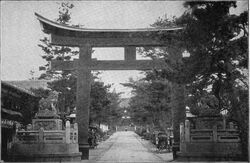
Gateway to Shinto shrine with torii gate
Shrines[]
The principal worship of kami is done at public shrines, although home worship at small private shrines (sometimes only a high shelf with a few ritual objects) is also common. It is also possible to worship objects or people while they exist. While a few of the public shrines are elaborate structures, most are small buildings in the characteristic Japanese architectural style. Shrines are commonly fronted by a distinctive Japanese gate (torii) made of two uprights and two crossbars. These gates are there as a part of the barrier to separate our living world and the world the kami live in. There are often two guardian animals placed at each side of the gate and they serve to protect the entrance. There are well over 100,000 of these shrines in operation today, each with its retinue of Shinto priests. Shinto priests often wear a ceremonial robe called a jo-e. Kami are invoked at such important ceremonies as weddings and entry into university. The kami are commonly petitioned for quite earthly benefits; a child, a promotion, a happier life. While one may wish for ill bidding on others, this is believed to be possible only if the target has committed wrongs first, or if one is willing to offer one's life. Though Shinto is popular for these occasions, when it comes to funerals most Japanese turn to Buddhist ceremonies, since the emphasis in Shinto is on this life and not the next. Almost all festivals (matsuri) in Japan are hosted by local Shinto shrines and these festivals are open to all those that wish to attend. While these could be said to be religious events, Japanese do not regard these events as religious since everyone can attend, regardless of personal beliefs.
Gods[]
Shinto's kami are collectively called Yaoyorozu no Kami (八百万の神), lit. eight million kami. The arcane name of eight million, Yaoyorozu is not the exact number, but the expression of infinite number from the time when the concept of infinity did not exist. While such usage has largely disappeared from the common use, until recently there were small shops often in suburbs that offered everything from perishable items like foods to magazines and newspapers, even occasionally a bicycle or a car, that were each called Yorozu-ya (万屋), lit. 10,000 shop, indicating the wide variety of items it offered.
The most widely worshipped of all kami is the sun-goddess Amaterasu. However, Japanese do not specifically worship her or invoke her name to ask for help. Her main shrine is at Ise, but many lesser shrines are dedicated to her. Within the shrine, she is often symbolised by a mirror. Alternatively, the inner sanctum may be empty. This emptiness does not mean non-existence; rather, it symbolizes that everything that one sees through the mirror is the embodiment of Amaterasu and every other kami.
Until the end of World War II, the Tenno (Emperor) was believed to have been descended from Amaterasu and father of all Japanese, and was therefore a kami on earth (an ikigami or "living kami"); this divine status was popularized during the Meiji Restoration. This did not prevent military governors (Shogun) from usurping power, but the emperor was always seen as the true ruler of Japan, even when his rule was only nominal. Although Emperor Hirohito renounced his divine status in 1946 under American pressure (Ningen-sengen), the imperial family remains deeply involved in the Shinto ritual that unifies the Japanese nation symbolically. Because Shinto doesn't require a declaration or an enforcement to be worshipped, which is actually "unharmonious" and is something to be avoided, this declaration, while serving political reasons, is religiously meaningless and merely means that the state enforcement has ended.
Ema[]
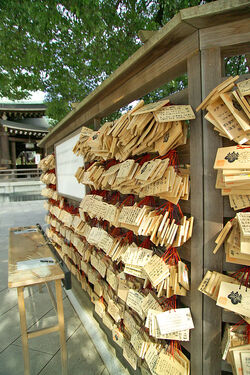
Ema at a Shinto shrine
In medieval times, wealthy people would donate horses to shrines, especially when making a request of the god of the shrine (for example, when praying for victory in battle). For smaller favors, giving a picture of a horse became customary, and these ema (絵馬) are popular today. The visitor to a shrine purchases a wooden tablet with a likeness of a horse, or nowadays, something else (a snake, an arrow, even a portrait of Thomas Edison), writes a wish or prayer on the tablet, and hangs it at the shrine. In some cases, if the wish comes true, the person hangs another ema at the shrine in gratitude.
Cultural effects of Shinto[]
Shinto has been called "the religion of Japaneseness", and the customs and values of Shinto are inseparable from those of Japanese culture prior to the influx of Chinese religious ideas that occurred in the mid 6th century. Many famously Japanese practices have origins either directly or indirectly rooted in Shinto. For example, it is clear that the Shinto ideal of harmony with nature underlies such typically Japanese arts as flower-arranging (ikebana) and traditional Japanese architecture and garden design. A more explicit link to Shinto is seen in sumo wrestling, where, even in the modern version of the sport, many Shinto-inspired ceremonies must be performed before a bout, such as purifying the wrestling arena by sprinkling it with salt. It is still very common for Japanese to say, "Itadakimasu" (I humbly partake) before eating, and the Japanese emphasis on proper greetings can be seen as a continuation of the ancient Shinto belief in kotodama (words with a magical effect on the world). Many Japanese cultural customs, like using wooden chopsticks and removing shoes before entering a building, have their origin in Shinto beliefs and practices. Also, a number of other Japanese religions, including Tenrikyo, have originated from or been influenced by Shinto.
Important shrines[]
- Main article: list of Shinto shrines
- Atsuta Shrine, Nagoya, Aichi, shrine to the Imperial sword Kusanagi
- Heian Jingu (Kyoto), dedicated to Emperor Kammu and Emperor Kōmei
- Ise Shrine (Ise), dedicated to Amaterasu
- Itsukushima Shrine, Hiroshima prefecture
- Iwashimizu Shrine, Yawata, Kyoto
- Izumo Shrine (Izumo)
- Kasuga Shrine, Nara
- Katori Shrine, Chiba Prefecture
- Kumano Shrines, Wakayama Prefecture
- Meiji Shrine (Tokyo), the shrine of Emperor Meiji
- Nikko Toshogu, Nikko, Tochigi Prefecture
- Tsurugaoka Hachiman Shrine, Kamakura, Kanagawa
- Usa Hachiman Shrine, Oita Prefecture
- Yasukuni Shrine (Tokyo), controversial shrine dedicated to the 'peace of the nation' and seen by some as a symbol of Japan's militaristic past
See also[]
- Culture of Japan
- History of Japan
- Japanese Buddhism
- Japanese mythology
- Japanese nationalism
- Jinja (Shinto)
- Libation
- Oomoto
- Religions of Japan
- Shinto music
References[]
- Littleton, C. Scott (2002). Shinto: Origins, Rituals, Festivals, Spirits, Sacred Places. Oxford University Press, Inc. ISBN 0195218868.
- Ueda, Kenji (1999). "The Concept of Kami". In John Ross Carter (Ed.), The Religious Heritage of Japan: Foundations for Cross-Cultural Understanding in a Religiously Plural World, pp. 65-72. Book East. ISBN ???.
External links[]
- Ema at Wikimedia Commons
- Kokugakuin University Encylopedia of Shinto
- Shinto - a Philosophical Introduction by Timothy Takemoto
- Shinto struggles to find a place in postwar society - a basic introduction to Shinto by Eric Talmadge for the Japan Times
- Emperor, Shinto, Democracy: Japan's Unresolved Questions of Historical Consciousness (ZMag)
- BBC - Religion & Ethics - Shinto
| This page uses Creative Commons Licensed content from Wikipedia (view authors). |